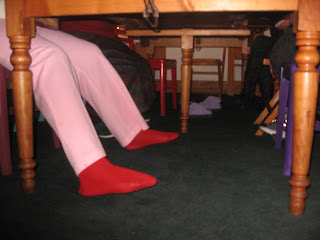However, if you really feel like delving into the details, here is a graph.
And for all you super OCD people, or the few of you who actually happen to care what I think, here is my actual post. Begin:
I have spent the past 2 1/2 weeks working 11 hours a day and commuting for 3 in order to bring you the latest findings in child acquisition of the second-person-singular formal and informal pronouns tú and usted. The results: doing experiments is really hard. Any little thing can ruin your results. Of all the children I tested, only one or two acted as I expected, reliably using the pronoun to choose the correct answer. All the other kids just pointed at random, or always chose the answer on the left side of the screen, or stupid non-linguistic, non-interesting things like that.
Oh, oops, what I meant to say is that they gave "non-adult-like" answers (= P.C. for "wrong").
On the other hand, I did get weekends off (hallelujah!), which I enjoyed to the max with my new friends Jorge Luis, Miriam, and Sergio. This is us at the pyramids of Teotihuacán.
 |
| These cuates helped me pass as a Mexican so I could get in free. Now that's friendship! |
 |
| Hello, yes, this is Hannah on pyramid. |
And this is me having the very authentic experience of grabbing a xoconoxtle and getting covered in spines.
For the rest of the day, it feels like having fiber glass particles in your skin. The only remedy is a liter of beer with lemon and chile.
Now about the tacos:
Okay, that says it all.
Now about the skulls: I have never seen a culture so obsessed with death. My first free day, I went to the museum of anthropology to learn a little about Mexico's roots. I knew that a lot of the pre-hispanic cultures practiced ritual human sacrifice. Something to do with making sure the rains would come, or whatever. But what I didn't realize was that it was not just a ritual, it was the ritual.
 |
| Decoration taken from the Avenue of the Dead, Teotihuacán. |
 |
| A human heart. How cute. |
 |
| People parts. |
And though that practice ended with the conquest, the preocupation with death and dying certainly did not. This from an exhibit at MODO (Museo del Objeto del Objeto) entitled «El modo de vivir la muerte»:
 |
| Woman with a dead child. |
 |
| Ofrenda de los niños con deformación cránea."The offering of children with cranial deformations." |
I just hope I make it home in one piece. If I don't, however, please have someone write my thesis for me.



































